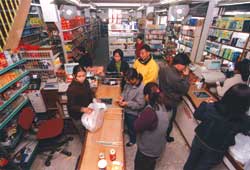 A few years ago, a survey found that tourists expressed interest in visiting Nepal again. They wanted to come back not because of the mountains, the temples or the weather but because of the people they met. Visitors, especially those who had also been to neighbouring countries, talked about being impressed with Nepalis who they described as "friendly", "helpful" and "sincere".
A few years ago, a survey found that tourists expressed interest in visiting Nepal again. They wanted to come back not because of the mountains, the temples or the weather but because of the people they met. Visitors, especially those who had also been to neighbouring countries, talked about being impressed with Nepalis who they described as "friendly", "helpful" and "sincere". The survey recommended that if the tourism officials needed a face to promote the industry, Nepali people could serve as excellent brand ambassadors to attract tourists to Nepal. But alas! The media campaign that came out soon after was a disaster. It glossed over Nepal, failing to communicate a single compelling theme as to why anyone should visit Nepal.
A similar story can be found in the Nepali handicraft sector too. For some years, handicraft artisans, producers, and retailers have had their own trade association, complete with a building and the inevitable organisational politics. But ask any of them what makes their products unique, what buyers see when they think of Nepali handicrafts or how the producers keep apace with contemporary designs, and you'll get either vague answers or boringly detailed explanations.
It seems that other than doing the production and hoping that buyers will somehow come, the mavens of the handicraft industry-busy as they are mouthing clich?s about poverty reduction and helping women entrepreneurs-rarely spend time articulating why anyone should want to buy more of their products.
And you can tease out more such stories when you scan industries for carpets, garments, tea, herbs, Nepali movies and even that of Chinese motorcycle dealers. The business people associated with these industries do not seem to understand that buyers' awareness about the goods and services alone does not translate into more sales. That is because few are told the reasons as to why they should want to buy more.
In this light, the matrix that Nepali industries find themselves in is like this: first, an opportunity to make money is identified. A spurt of growth occurs in the initial phase. This is characterised by the rush of a number of players of varying quality, who, for a brief while, do rather well, attracting even more players to the industry. It culminates in the solemn formation of an all-Nepal association of the industry.
But things start going downhill after everyone gets together for the trade association. Suddenly, there emerges a collective inability to take the industry to a greater level of market sophistication. Growth slows, players start to quarrel over market shares, personality clashes turn associations into personal fiefdoms, and the politicians are blamed. Once promising industries fail to live off their own earnings, they are doomed to stay inefficient cottage industries that constantly need donor money and government subsidy.
Is there a way out of this? One approach, already adopted by some in the pashmina industry, could be for associations to focus on understanding why anyone would or would not want to buy their industries' goods and services. Once that is established, then the associations could brand their products in ways that convey value to customers. For instance, a pashmina company advertisment says their product looks "great at any age". This branding exercise increases demand. The handicraft industry could adopt such an approach by communicating the finesse of century-old Newari craftsmanship. And for tourism, this might mean inviting tourists to be, well, guests of Nepalis in Nepal and then enjoy the mountains and more.



